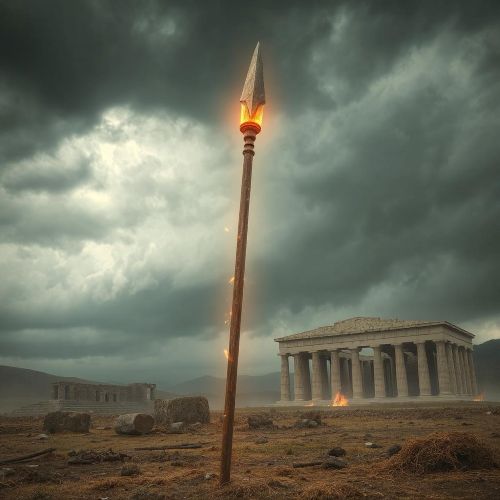Kartikeya’s Vel : The Spear of Victory
Karthikeya’s Vel
Introduction
Karthikeya, also revered as Murugan, Skanda, or Subrahmanya, is a powerful deity in Hindu mythology known for his unwavering commitment to justice, his exceptional martial prowess, and his profound wisdom. Among the many symbols associated with him, the Vel—his divine spear—stands as the most iconic. More than a mere weapon, Karthikeya’s Vel is a spiritual emblem, embodying the power of Shakti (divine feminine energy) and the triumph of light over darkness. It plays a central role in his mythology and is celebrated in rituals, festivals, and temples throughout South India and the Tamil diaspora.
Origins
The story of the Vel begins with divine intention. When malevolent asuras (demons) such as Tarakasura and Surapadman began threatening the stability of the cosmos, the gods turned to Karthikeya as their savior. To empower him for this daunting mission, Goddess Parvati—his divine mother—bestowed upon him the Vel. This was not merely a gesture of maternal love but an act of channeling her inner Shakti into a form that Karthikeya could wield.
One of the earliest legends associated with the Vel is found in the Skanda Purana, which recounts how Parvati created the spear through intense tapas (austerity) and gifted it to her son before his battle against Surapadman. The Vel thus emerged as a weapon infused with spiritual energy, crafted not by conventional means but through divine intent and cosmic necessity.
Think you know your myths and legends? Dive into the world of ancient stories and test your knowledge with our engaging quizzes on Mythlok!
Powers
Beyond its role in warfare, Karthikeya’s Vel is a symbol of illumination and divine justice. Its sharp point represents the piercing nature of wisdom, cutting through the veils of illusion (maya) and ignorance. Just as a spear penetrates physical armor, the Vel is believed to pierce the ego and awaken consciousness, making it a metaphor for inner awakening.
Spiritually, the Vel serves as an instrument of dharma, or righteous living. It is said to contain the power to dissolve karmic bondage and guide souls toward liberation. Many devotees see the Vel as a source of inner strength, capable of warding off negative energies and helping them overcome personal struggles.
In iconography, Karthikeya is almost always depicted with the Vel in hand, often standing tall atop his mount, the peacock. The peacock itself is a symbol of beauty and victory, and when paired with the Vel, the image becomes a representation of grace guided by purpose.
Owners/Users
Unlike many divine weapons in Hindu mythology that are passed down or shared among gods, the Vel remains exclusively associated with Karthikeya. This exclusivity underscores the depth of its connection to his divine persona. He is sometimes affectionately called Vēlaṇ—literally, “the one with the Vel”—a name that reinforces the intimate relationship between the god and his spear.
Temples dedicated to Karthikeya often have the Vel enshrined as the central object of veneration. In many cases, it is treated with the same reverence as the deity himself. During key festivals like Thaipusam, millions of devotees carry miniature Vel replicas, undergo physical trials, and even pierce their skin with silver spears in acts of devotion and penance, all to honor the sacred power of the Vel.
Instances used
The Vel’s legendary status is solidified through the many tales of victory in which it features. One of the most prominent stories is Karthikeya’s battle with Tarakasura, a demon who had grown invincible thanks to a boon from Lord Brahma. None of the gods could defeat him, for the boon had declared that only Shiva’s son could bring about his end. Armed with the Vel, Karthikeya fulfilled this prophecy and restored order.
Another significant myth is the confrontation with Surapadman, who represents ego and ignorance. As the battle reached its climax, Surapadman transformed himself into a mango tree to escape defeat. Karthikeya, unwavering in his mission, hurled the Vel, splitting the tree in two. From one half emerged a peacock, which became his mount, and from the other, a rooster, which adorned his banner. This act wasn’t just about physical conquest—it symbolized the transformation of arrogance into divine service and chaos into harmony.
These mythological accounts highlight that Karthikeya’s Vel isn’t just a tool of destruction, but a catalyst for transformation—turning fear into faith, ignorance into awareness, and darkness into light.
Frequently Asked Questions
Lorem ipsum dolor sit amet, consectetur adipiscing?
Lorem ipsum dolor sit amet, consectetur adipiscing elit. Praesent convallis vestibulum justo, ac tincidunt nunc vehicula quis. Nullam id dolor quis orci malesuada feugiat. Curabitur aliquet libero at urna ullamcorper, ac ultricies nulla dapibus.
Lorem ipsum dolor sit amet, consectetur adipiscing?
Lorem ipsum dolor sit amet, consectetur adipiscing elit. Praesent convallis vestibulum justo, ac tincidunt nunc vehicula quis. Nullam id dolor quis orci malesuada feugiat. Curabitur aliquet libero at urna ullamcorper, ac ultricies nulla dapibus.
Lorem ipsum dolor sit amet, consectetur adipiscing?
Lorem ipsum dolor sit amet, consectetur adipiscing elit. Praesent convallis vestibulum justo, ac tincidunt nunc vehicula quis. Nullam id dolor quis orci malesuada feugiat. Curabitur aliquet libero at urna ullamcorper, ac ultricies nulla dapibus.
Lorem ipsum dolor sit amet, consectetur adipiscing?
Lorem ipsum dolor sit amet, consectetur adipiscing elit. Praesent convallis vestibulum justo, ac tincidunt nunc vehicula quis. Nullam id dolor quis orci malesuada feugiat. Curabitur aliquet libero at urna ullamcorper, ac ultricies nulla dapibus.
Lorem ipsum dolor sit amet, consectetur adipiscing?
Lorem ipsum dolor sit amet, consectetur adipiscing elit. Praesent convallis vestibulum justo, ac tincidunt nunc vehicula quis. Nullam id dolor quis orci malesuada feugiat. Curabitur aliquet libero at urna ullamcorper, ac ultricies nulla dapibus.
Watch
Source
Clothey, Fred W. The Many Faces of Murukan: The History and Meaning of a South Indian God. Walter de Gruyter, 1978.
Dalal, Roshen. Hinduism: An Alphabetical Guide. Penguin UK, 2010.
Mann, Richard. Skanda: Hindu God of War and Victory. University of California Press, 2011.
Lochtefeld, James G. The Illustrated Encyclopedia of Hinduism. Rosen Publishing, 2002.
Contributors to Wikimedia projects. (2004). Kartikeya – Wikipedia. https://en.wikipedia.org/wiki/Kartikeya
Kartikeya’s Vel: The Divine Spear – Meaning, Significance, and … (2025). https://www.poojn.in/post/30448/kartikeyas-vel-the-divine-spear-meaning-significance-and-legends?srsltid=AfmBOoqRbOA_LsywQNgTj5En7-ID2ciIaoV37c3OZZranba1gIIgS6Fb
Contributors to Wikimedia projects. (2006). Vel – Wikipedia. https://en.wikipedia.org/wiki/Vel
Kartikeya and the Spear Vel – Temple Yatri. (2024). https://templeyatri.in/kartikeya-and-the-spear-vel/
Information About Lord Kartikeya (Murgan) Swami – Rudraksha Ratna. (n.d.). https://www.rudraksha-ratna.com/articles/lord-kartikeya?srsltid=AfmBOoonIXo-IRFf9kMDPZ0ImEOB6vnWt-8x_yYR5hQsV2ESmkySpeZa








